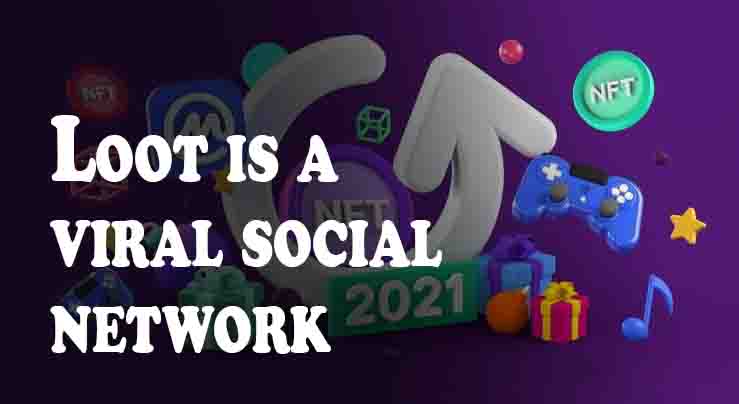You have not seen anything like Loot before. Loot is a viral social network that looks unlike anything you have seen before. Dom Hofmann discusses the origins of Loot, the communities, creative aspects, the speculation about NFTs that spawned from it, as well as the future prospects for the project in his interview.
‘Loot’ creator Dom Hofmann talks about creating a game, a financial asset, a project for art, or a metaverse (?) based on open-source software and decentralization.
Here’s how a co-founder of Vine’s latest project tells us about the tech industry’s evolution. Almost every aspect of this tech story surprised me in some way. Despite some of the ideas here being so far out there that I imagine many of you will slam your laptops shut in disgust, the far frontier they represent appears to be inching close to the mainstream.
Table of Contents
1. The road to Loot
My March article about non-fungible tokens dazzled with sales figures of $600,000 for Nyan Cat, $5.8 million for Grimes’ artwork, and $230 million for NBA Top Shot.
Those numbers seem minuscule now compared to what has happened since then. A portion of ownership in the original doge meme NFT, which had been purchased in June for $4 million, was sold via tokens on Thursday. Buyers snapped up the token for $225 million. (Coindesk has a great explanation.)

People continued to create, acquire, and trade NFTs despite them slipping out of mainstream press headlines.
Then we have Dom Hofmann. Hofmann co-founded Vine, a short-form video format for mobile devices that helped establish meme culture. After Peach’s brief moment in the spotlight faded, its users remained loyal to it even after its brief appearance. Recently he tried to revive Vine as a mobile app called Byte, which sold.
In the past decade, Hofmann had kept an eye on the world of cryptocurrencies, occasionally buying coins to learn more about them. Until recently, the blockchain was mostly associated with Bitcoin. Recently, however, developers have grown fond of Ethereum, a blockchain designed to allow decentralized applications with smart contracts more sophisticated than Bitcoin.
Initially, nothing of interest to the mainstream materialized after Ethereum was invited. Last year, some companies built decentralized finance apps on its blockchain, known as “DeFi summer,” and started growing really fast. (Writing about blockchain technologies is hard because there are so many names involved.)
When Ethereum proved to be able to generate huge amounts of cash, developers started flocking to it in droves.
One was Hofmann. Solidity is the programming language for creating Ethereum smart contracts, which he began learning in December. His NFT art piece was also sold and he enjoyed the process. NFTs inspired decentralized creative projects more and more as he created.
He created a fantasy universe called Blitmap back in March, which would serve as a guide for Loot.
Through the collaboration of 16 other artists, Hofmann developed 100 32-by-32 pixel images that were then remixed into 1,600 “siblings.” The Blitmaps would be used as the basis for a blockchain-based Marvel Cinematic Universe, making characters available for merchandise and gaming. Blitmaps today cost about $98,000, which was a modest success.
Importantly, it paved the way.
2. Loot drops
He also created a text-based adventure that served as inspiration for some early video games. His development process included creating a random item generator, which returned names for weaponry, armor, and accessories.
As Blitmap launched, Hofmann had considered other innovative ways to promote blockchain-based art. He proposed allowing people to create free NFTs by using his random-item generator – basically for testing purposes. Artwork and instructions on how to use it were not provided. His “bags” of items would be given away for free, minus Ethereum transaction fees.
Several people have been asking for a fantasy or science-fiction game to be compatible with other worlds. On top of that, they want to build. Knowing that their items will always be there is important to them. I just kind of built in that direction. I experimented.”
The only thing he was trying to accomplish was to make sure that all the bags were available for minting.
3. Future games
As for what comes next, Hofmann says that he has no intention of working on Loot full-time. Due to the decentralized nature of the project, he does not believe he could truly steer the community, even if he wanted to. As a result of the hundreds of bags that he has not yet released for minting, he remains the largest shareholder in the project.
There has always been the downside to the blockchain: that at some point, the enthusiasm for it would wane, and everyone would lose their money in the process. I’ve never been quite that bearish myself, but I do understand: to the average person, it has not yet become clear what the point of a blockchain is.
The one thing that has always kept me from being a blockchain bear is that I know a lot of smart people who are working on this technology every year, and that makes me hesitant to give it a try. If you wager that Ethereum will fail, you are betting against a growing number of talented individuals. The odds on that bet do not feel great to me today, and they are getting worse every minute that passes.
